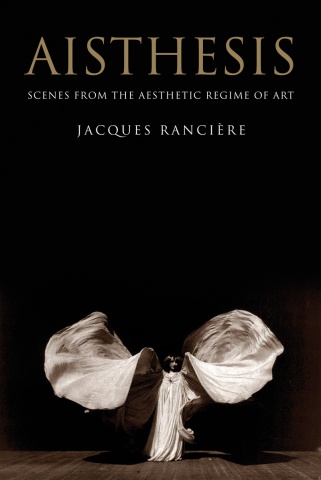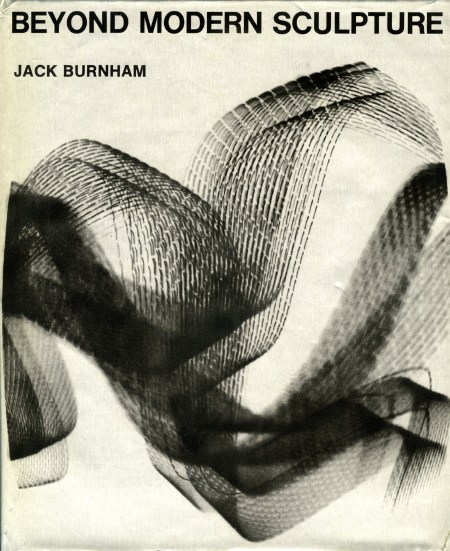Jacques Rancière: Aisthesis: Scenes from the Aesthetic Regime of Art (2011/2013)
Filed under book | Tags: · aesthetics, art, art history, art theory, body, cinema, dance, film, life, literature, music, painting, pantomime, philosophy, photography, poetry, politics, representation, sculpture, theatre, theory

Rancière’s magnum opus on the aesthetic.
“Composed in a series of scenes, Aisthesis–Rancière’s definitive statement on the aesthetic–takes its reader from Dresden in 1764 to New York in 1941. Along the way, we view the Belvedere Torso with Winckelmann, accompany Hegel to the museum and Mallarmé to the Folies-Bergère, attend a lecture by Emerson, visit exhibitions in Paris and New York, factories in Berlin, and film sets in Moscow and Hollywood. Rancière uses these sites and events—some famous, others forgotten—to ask what becomes art and what comes of it. He shows how a regime of artistic perception and interpretation was constituted and transformed by erasing the specificities of the different arts, as well as the borders that separated them from ordinary experience. This incisive study provides a history of artistic modernity far removed from the conventional postures of modernism.”
First published as Aisthesis : Scènes du régime esthétique de l’art, Éditions Galilée, 2011
Translated by Zakir Paul
Publisher Verso Books, 2013
ISBN 1781680892, 9781781680896
304 pages
via falsedeity
Reviews: Hal Foster (London Review of Books), Joseph Tanke (Los Angeles Review of Books), Marc Farrant (The New Inquiry), Ali Alizadeh (Sydney Review of Books), Jean-Philippe Deranty (Parrhesia).
Roundtable discussion with Rancière at Columbia (video, 43 min)
Selected interviews and reviews (in French)
Rosalind Krauss: Bachelors (1999)
Filed under book | Tags: · aesthetics, art, art criticism, art history, art theory, feminism, fetish, sculpture, surrealism, women

“Since the 1970s Rosalind Krauss has been exploring the art of painters, sculptors, and photographers, examining the intersection of these artists concerns with the major currents of postwar visual culture: the question of the commodity, the status of the subject, issues of representation and abstraction, and the viability of individual media.
These essays on nine women artists—gathered as Bachelors—are framed by the question, born of feminism, “What evaluative criteria can be applied to women’s art?” In the case of surrealism, in particular, some have claimed that surrealist women artists must either redraw the lines of their practice or participate in the movement’s misogyny. Krauss resists that claim, for these “bachelors” are artists whose expressive strategies challenge the very ideals of unity and mastery identified with masculinist aesthetics. Some of this work, such as the “part object” (Louise Bourgeois) or the “formless” (Cindy Sherman) could be said to find its power in strategies associated with such concepts as écriture feminine. In the work of Agnes Martin, Eva Hesse, or Sherrie Levine, one can make the case that the power of the work can be revealed only by recourse to another type of logic altogether. Bachelors attempts to do justice to these and other artists (Claude Cahun, Dora Maar, Louise Lawler, Francesca Woodman) in the terms their works demand.”
Publisher MIT Press, 1999
October Books
ISBN 0262112396, 9780262112390
228 pages
Reviews: James Elkins (CAA Reviews 1999), Fred Andersson (Leonardo 2000).
Comment (0)Jack Burnham: Beyond Modern Sculpture: The Effects of Science and Technology on the Sculpture of This Century (1968)
Filed under book | Tags: · art, art history, art theory, kinetic art, machine, sculpture, technology

Examines the materialistic and psychological factors responsible for dominant trends in twentieth-century sculpture.
Publisher George Braziller, New York, 1968
ISBN 0807607150, 9780807607152
402 pages
Reviews: Walter Darby Bannard (Artforum, 1969), Louis Vaczek (Technology and Culture, 1970), James Ackerman (The New York Times Books, 1969, Burnham’s response), Charlotte Willard (The Saturday Review, 1969)
PDF (updated on 2014-3-27)
PDF (120 MB, no OCR, added on 2023-8-4)

